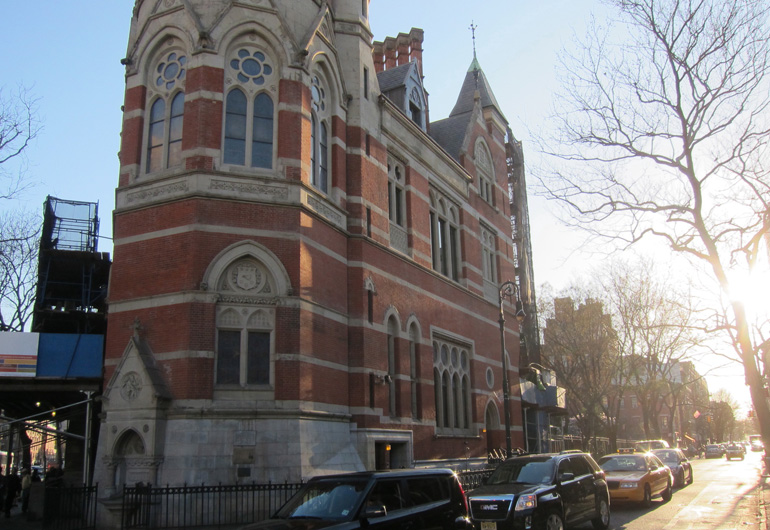Gotham Diary:
Dyson’s Batch Dump
10 April 2012
Looking back, I see that George Dyson gives, at the opening of Turing’s Cathedral, his “history of the digital universe, a fair warning of where he’s headed.
At 10:38 PM on March 3, 1953, in a one-story brick building at the end of Olden Lane in Princeton, New Jersey, Italian Norwegian mathematical biologist Nils Aall Barricelli inoculated a 3-kilobyte digital universe with random numbers generated by drawing playing cards from a shuffled deck… “with the aim of verifying the possibility of an evolution similar to that of living organisms taking place in an aritificially created universe.
But only in retrospect. Only much later, in this book that feels so much longer than it is, do we see why a story that seems at times infatuated with the Central European mathematical wizards, largely from Budapest, who were driven to the United States by Hitler’s insanity, and equally infatuated by the place to which they were driven, the Institute for Advanced Study at Princeton — only near the end do we see why such a story begins with a relatively eccentric figure who spent little time at the IAS and who, were a movie to be made of Turing’s Cathedral, would have to be played by John Tuturro.
As for the title, it’s a shibboleth. Either you get it or you don’t. I expect that a reference to Darwin’s Cathedral, by David Sloan Wilson, but, as I haven’t read that book, I can’t make more sense of it than that. All that’s certain is Turing’s Cathedral is not about Alan Turing.
***
I discern at least three different books within the covers of this one. Three different kinds of books, books having little to do with one another even where nominal subject matter overlaps. The first book is a scrapbook of the early days of the IAS, which, you won’t be surprised to learn, George Dyson grew up, as his father, Freeman, had migrated to Princeton before he was born. We meet a lot of interesting characters and we hear a lot of interesting founding stories, all about the Institute. We meet Alice Rockafellow, who managed the cafeteria. Even when the anecdotes are engaging, the overall tone is that of a rather dreary institutional history, written to the anniversary of something. Individuals flash alive for a moment or two, but IAS itself is just a building — Fuld Hall.
Long before Dyson is done with this story, however, he picks up another one, and proceeds to tell it backwards. This is the story of John von Neumann and the bomb. The bomb was always the thermonuclear device that we call the “hydrogen bomb”; the “atomic bomb” that was dropped on Hiroshima (and then again on Nagasaki), was no more than the detonator of the intended bomb, which could not be designed without the aid of electronic computers. That’s why the story of computers is a postwar story: the blasts that took Japan out of the War suggested that von Neumann and others were on the right track, weapons-wise, and that the government ought to fund the development of the computer that they claimed to need in order to build a proper thermonuclear device. If this thumbnail is mistaken or misleading, it’s no thanks to Dyson, about whom I can only say that the grain of his sense of organization is very unlike my own. Â
The third book is about life, self-replication, and who’s in charge, men or computers? Dyson is coy about the nonfictional nature of his ostensible science fiction. He even sets it forth in a bit of dialogue, over lunch with the 91 year-old Edward Teller, to whom he proposes the following:
My own personal theory is that extraterrestial life could be here already … and how would we necessarily know? If there is life in the universe, the form of life that will prove to be most successful at propogating itsself will be digital life; it will adopt a form that is independent of the local chemistry, and migrate from one place to another as in electromagnetic signal, as long as there’s a digital world — a civilization that has discovered the Universal Turing Machine — for it to colonize when it gets there. And thats why von Neumann and you other Martians got us to build all those computers, to create a home for this kind of life.
Teller gnomically urges Dyson to present this as science fiction. You can almost see the other wizards in the room turning their signet rings in a propitious direction. This is where Barricelli comes in. (Do we have something of a record here for the shortest Wikipedia entry?) I suspect that Dyson’s three books would cohere somewhat better on a second reading, but I’m firm about their remaining three different books.
***
I realize that we’ve been having an unseasonably warm spring — Willy, the barber, is worried about temperatures breaking a hundred during May — my junkets to the Shake Shack have not been kissed by atmospheric clemency. Last week, it was windy and freezing, ditto the week before. Today, the air was milder, but it rained. It rained just enough for me to tuck the NYRB inside my jacket whilst continuing stolidly with my lunch.
***
Will Thomas Kinkade’s untimely death catch serious writers about art unprepared? Anyone who has sympathetically toured a collection of Old Master paintings lately will understand instantly that Kinkade’s output was not “art.” But what is it, then? Is it not art because it’s not good enough (a matter of degree — in Kinkade’s enormously lucrative case, of calculated “errors” intended to snare the unsophisticated — or is it not art because it is something else, something that could exist only in an age of affluence, when materials could be wasted without consequence. (The unsophisticated buyers of art, two centuries ago, were few and far between, and highly unlikely to indulge their own native tastes. They’d buy what their nearest betters bought.) In Kinkade’s case, the materials are doubly wasted: the paint and so forth, and then the buyers’ money. No one will want Kinkades in ten or twenty years, because kitsch, like forgery, is stuck to its own time in a way that great painting is not. The paintings, far from rare as it is, will become curiosities in which only a small group of fans will be interested. (Unless, of course, the Idiocracy scenario plays out.)
I’m inclined to the latter view: kitsch as a personal accessory, like an expensive handbag. Hanging over the living room sofa, the painting of a country chapel, lights aglow in the early dusk, is a sign to those granted entry. In this, I would venture to say (having forgotten everything that I ever knew about semiotics), it is unlike the expensive handbag, about which there will always hang a bit of mystery (why pay so much for a purse, and why that particular sack?). Status markers flirt with the danger of the emperor’s new clothes; sometimes, especially at the low end of the price range, the material value of a status object is nil. Signs are unambiguous (even if there’s more to them than first impression reveals). A Kinkade on the wall says: “We’re pious Americans who maintain family values. Because it would be rude to insist on this point by affixing a literal statement to the wall, we have chosen this painting to convey the message.” As something to look at, a Kinkade can only be a point of departure, a seeder of recollection and wishful thinking that carries the owner/viewer to an inner space.
And can’t precisely the same be said of the work of Damien Hirst, for all that he operates at the very opposite pole of the art market?

















